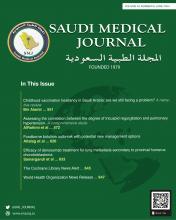To the Editor
The study by Sen et al1 looks at the correlation between cortisol and glycosylated hemoglobin (HbA1C) levels and intensive care unit (ICU) patient mortality. The study provides useful information. However, there are several methodological and interpretation issues requiring to be addressed.
The study’s retrospective design and small sample size of 79 patients raise questions regarding the validity and generalization of the findings. Potential biases in patient selection and data collecting impose inherent limitations on retrospective research. Furthermore, a sizable section of the ICU population may have been excluded due to the exclusion criteria (such as patients receiving postoperatively treatment or steroids), which might have restricted the data’ generalizability in a wider clinical setting.
According to research on the responses to stress in critical illness, increased cortisol levels strongly predict death (p=0.017).2 However, the study does not provide a thorough analysis of the confounding variables that might alter cortisol levels, such as concurrent infections, drugs, and physiological stresses without any connection to ICU admission. To prevent overestimating cortisol’s predictive potential, these factors must be carefully taken into account when using it as a stand-alone predictor.
According to some earlier research that suggested a connection between long-term glycemic management and ICU outcomes, the study’s conclusion is that HbA1C levels have not been substantially connected with mortality (p=0.166).3 The limited range of HbA1C readings found (median: 5.7%) and the very small number of diabetic individuals examined may be the cause of this disparity. The researchers needs to investigate if a larger diabetes group or a wider range of HbA1C values may produce different outcomes.
According to Czajka et al,4 the APACHE II score has been shown to be a reliable predictor of death (p=0.005), supporting its established utilization in critical care. A more detailed examination of the interactions between cortisol, HbA1C, and the APACHE II score would be beneficial for the purpose of the research. For example, does cortisol’s predictive value decrease or does it increase when accounting for APACHE II, or do they offer further insights?
Although logistic regression is used in the study, any multicollinearity between variables is not well addressed. Because the physiological indicators of patients in the ICU are interrelated, multicollinearity may cause a considerable distortion in the prediction models. The findings would be strengthened by a more comprehensive statistical study that included tests for multicollinearity and model robustness.
Although the study offers cortisol as a potential predictor of ICU mortality, the results are limited by the small sample size and retrospective approach. To verify these results, bigger, more varied cohorts will be required in prospective research. Furthermore, it might be beneficial to re-evaluate the exclusion of specific patient categories (such as those who utilize steroids) in order to improve the generalizability of future studies.
Sen et al’s1 work adds to the current discourse on biomarkers in critical care by emphasizing cortisol levels’ potential as a mortality predictor. However, the results should be interpreted cautiously due to the limitations in the study design, sample size, and statistical analysis. To offer more definitive conclusions regarding the effects of cortisol and HbA1C in predicting ICU outcomes, future research should address these concerns.
Reply from the Author
No reply was received from the Author.
- Copyright: © Saudi Medical Journal
This is an Open Access journal and articles published are distributed under the terms of the Creative Commons Attribution-NonCommercial License (CC BY-NC). Readers may copy, distribute, and display the work for non-commercial purposes with the proper citation of the original work.






